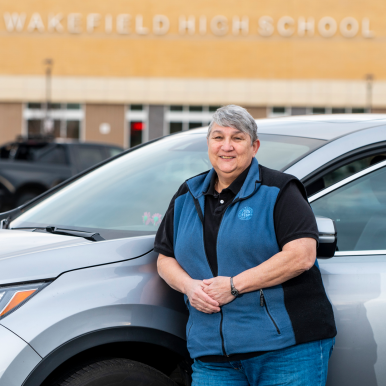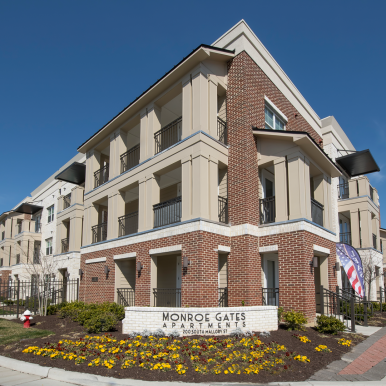Hitting a brick wall
Climbing housing costs pose workforce challenges
Hitting a brick wall
Climbing housing costs pose workforce challenges
Casey Renner has worked in four states over the course of her teaching career, and she’s never liked a school more than Arlington County’s Wakefield High School, where she teaches science and special education.
But she has also never had as much difficulty finding housing near work as she has during her 17 years teaching in Arlington. While Renner searches every year for an affordable rental where she can live with her cat and border collie, her searches repeatedly come up empty, and she has learned the art of reading the traffic tea leaves before starting her daily commute home to District Heights in Maryland, where she rents a basement apartment at below-market rate from friends.
“On a good day, my commute is 35 to 45 minutes,” she says. “On bad days, I just give up and do some errands or grade papers at Ted’s Montana Grill and drive home after 7 p.m.”
The long commutes discourage Renner and other teachers from attending students’ games and performances and offering extra help after the final bell rings.
“A big dream of mine has always been to live where I work, because I think you can make a bigger difference when you are actually part of the community where you teach,” says Kimberly Pearson, a middle school language arts teacher in Arlington.
As a single mother, Pearson had to get financial help from her parents to pay the rent on her two-bedroom apartment, which took up 56% of her annual salary.
Hoping to escape rising rents, and to invest in the community where she was teaching, she stretched to purchase a house in the Fairlington neighborhood of Arlington.
“I tried for two years to make it work, but the costs and taxes have gone up so much,” says Pearson, who tried unsuccessfully to get homeownership assistance through Arlington County’s housing office, tutored after school for extra money and worked summer school to try to make ends meet. The burden was so severe that she sold her home, moved to Manassas, and plans to seek employment closer to home.
“It felt like a judgment from the community, a message that, ‘We want someone educated and highly skilled to be here, but we don’t want you to be our neighbor,’” she says.

Joshua Folb, a math teacher at Washington-Liberty High School in Arlington, says the problem impacts not only teachers, but also bus drivers, custodians, cafeteria workers and others critical to school operations.
“There is almost no place left in Arlington that somebody working a job in our cafeteria could look out the door of the school and afford renting,” he says. “You really are coming in to serve the kids of other people.”
In his work on the Virginia Education Association’s resolutions committee, Folb sees the problem impacting educators across the state, to the point that the group has added housing affordability to its list of belief statements. “One of the things we believe is that school districts should pay wages that allow for an employee to live with dignity in the location in which they work,” he says. “Part of living with dignity would be not having to drive an hour and a half to make just above minimum wage.”
Across Virginia, workers at many different income levels are finding it increasingly harder to rent or buy a home in the communities where they work. This is sparking new discussions among local governments, economic development leaders and employers about how to tackle the age-old problem of affordable housing.
What is ‘affordable’?
The federal government defines housing as “affordable” if it costs no more than 30% of a household’s monthly gross income. Federal programs to support affordable housing base their qualifications on what percentage of area median income (AMI) a household earns. Most of these programs serve households making under 80% of AMI, and many are limited to those under 60% of AMI.
An analysis of federal wage data shows that an increasing portion of the workforce fits into this definition in Virginia’s most populous areas.
The average elementary school teacher in the Washington, D.C., metro area, which includes Alexandria and Arlington, makes 66% of area median income. The average police patrol salary in the Richmond area is 65% of AMI. And in tourism-heavy Hampton Roads, the average waiter or waitress brings home 29% of AMI.
In all of these markets, child care workers and home health aides — two professions that are greatly in demand — make on average under 30% of area median income. The federal government defines this as “extremely low income.”
When higher-paying jobs raise an area’s median income, but the wages of service-based jobs that are essential to the community don’t follow, many of these workers find themselves priced out of the market.
Steve Lawson, board chairman of Virginia Beach-based Lawson Cos., a multifamily development, construction and management firm, says his company is now developing more affordable housing than market-rate housing, specifically because the demand is so high. But he notes that the resources available to finance affordable housing — particularly the federal low-income housing tax credit (LIHTC) — are nowhere near enough to meet the need that exists.
While LIHTC properties are generally limited to tenants making 60% AMI or less, Lawson says there is a large segment of the renters’ market he calls “no man’s land” — people who don’t qualify for low-income housing but also can’t afford market-rate housing.
“There is a real need there,” he says. “For years, we have seen when we build a new community [that] people walk in to apply and say, ‘Please don’t tell me I make too much money to live here, because I have looked all over town for a decent place.’”

This is a trend that Arlington County Housing Director Anne Venezia has observed in her 14 years with the county.
“We are seeing less income diversity in Arlington than we were a decade ago,” she says. Housing affordability presents an issue for some workers making up to 100% of Arlington’s median family income of $129,000. Moderate-income workers such as teachers and firefighters are having an even harder time finding a place to live.
“A decade ago, these households were able to rent in Arlington fairly easily and could pursue homeownership in some of our neighborhoods,” she says. “But the availability of housing for those groups is increasingly limited because of increasing prices and the ability of higher-earning households to pay more.”
Historically low interest rates and limited inventory drove the median home sales price for the entire state of Virginia to $350,000 in 2021, according to data from Virginia Realtors. That’s a 9.4% jump from 2020’s median home sales price, the largest increase in several years. As mortgage rates ticked up in early 2022, these homes became even less affordable.
Meanwhile, demand for rental housing has increased, driven by higher sales prices, and the average effective monthly rent cost went up 11.3% in the fourth quarter of 2021 compared with prices a year earlier. Virginia Realtors reported that it was the greatest year-over-year growth since at least 2000.
“Affordability is a growing challenge throughout Virginia,” says Lisa Sturtevant, chief economist for Virginia Realtors.
Supply-demand mismatch
Housing production in Virginia has never recovered to levels that predated the 2007-2009 Great Recession, according to a statewide housing study completed this year by Virginia Housing and the state Department of Housing and Community Development. Localities in Virginia issued 63,215 residential building permits in 2004, but that number shrank to a mere 33,813 in 2020.
Demographics compound the problem. Since 2008, Virginia’s population has grown by 10.2%. The housing supply, however, has grown by only 8.7%, according to the study. Add to this the fact that the number of households with only one or two people is growing faster than the number of larger households, and Virginia faces a crucial need to adapt its housing stock for a population that looks a lot different from just a decade ago.
“There is a real imbalance between the housing supply and the demand that is out there,” says Jonathan Knopf, vice president of Richmond-based affordable housing consultancy HDAdvisors and a researcher on the state housing study. He says the numbers tell a story that is starting to change the way state policymakers talk about affordable housing.
“Pre-2008, most of the affordable housing discussion was around very low-income people,” he explains. “But more recently, because of that lack of supply, folks in the middle-income space, especially in high-growth areas, are starting to say, ‘I make a decent amount of money; I am not a minimum-wage worker. Why is it tough for me to find affordable housing in the community that I work in?’”
Developers point out that the market is so supply-constrained that slightly older apartments don’t come at the discount they once did.
“If you look at the gap between 10-year-old product and brand-new product, that gap is not nearly what it was 10 years ago,” says Tim Faulkner, president and CEO of The Breeden Co., a Virginia Beach-based residential developer.
This means that preserving the oldest rental housing stock — and preventing it from being bought by an investor who intends to reposition it as a luxury product — has become an important piece of the affordable housing solution.
Faulkner says Breeden sees the investments it makes in its oldest housing stock — such as a $15 million renovation recently completed at Emerald Point, an 863-unit apartment and townhome community in Virginia Beach originally built in 1968 — as an important way to keep affordable housing on the market.
“The rent gaps between that level of housing and the Class A product may be as much as $1,600 a month,” he says, adding that a 5-year-old residence may carry only a $500 monthly discount compared with a brand-new development.

Businesses seek a role
Bill Flattery, CEO of Carilion New River Valley Medical Center in Christiansburg, leads a group within The Blacksburg Partnership business organization seeking strategies to address the growing affordability problem in the New River Valley region.
The New River Valley Regional Commission teamed with the Virginia Center for Housing Research at Virginia Tech to conduct a housing study starting in 2018. The study identified a need for at least 5,500 income-restricted units in the region to stabilize low- and moderate-income residents who were spending more than 50% of their income on housing. Another 9,000 residents were found to be paying more than 30% of their income for housing.
Flattery says the problem threatens to make Blacksburg a less diverse community, a place where only people who make a certain income — or college students who get help from their parents — can afford to live. On a practical level, the problem is having a direct impact on business expansion plans, Flattery says, including his own hospital.
“We are competing for workers now. In order for us to keep people here, we have to do considerable wage consideration, and part of that is the affordability of housing in our area,” he says. “That middle-income group just can’t access it. This does impact our expansion plans, our ability to recruit and retain, and I know that’s true for other businesses in our area.”
Jason El Koubi, director of the Virginia Economic Development Partnership, says housing availability became an issue when Virginia was in the running recently for a major advanced manufacturing project with the potential to bring several thousand new jobs to a small metro area with a large, high-quality industrial site.
“During the recruitment process, the company expressed concerns around the housing inventory within the community that would be required to accommodate the growth from a project of its scale,” he says. “Virginia was ultimately eliminated for various different reasons, but we believe workforce housing issues were a chief concern.”
Zoning shortfalls
Housing experts and developers agree that local zoning ordinances skewed toward detached single-family homes are a major barrier to increasing the state’s housing inventory.
“The artificial restrictions on supply and land for new housing via local land-use regulation is pretty much the No. 1 challenge that we hear from housing providers across the state,” Knopf says.
In many localities, zoning policy favors traditional cul-de-sac neighborhoods in part because of the perception that denser residential developments cost more than they contribute to local coffers, with residents requiring more spending on schools, roads and other services, without bringing in the taxes that retail and employers generate.
Builders and many housing equity advocates counter that this line of analysis leaves out the benefits that new residents bring in terms of purchasing power and manpower for employers.
“It’s almost like doing a cost-benefit analysis where you only talk about the costs,” says Sturtevant, who has studied housing market trends for more than two decades. “What doesn’t get told is to what extent not having sufficient housing could hurt your overall local economy.”
A 2021 study by the Joint Legislative Audit and Review Commission (JLARC) noted that while multifamily residential is the most-needed housing type in the state, very few Virginia localities zone more than 50% of their land for multifamily. Efforts to have a parcel rezoned for this type of development can cost as much as $1 million, the report states, making it cost-prohibitive to finance a development with affordable rents.
Financing solutions
Controlling costs and providing capital lie at the heart of boosting the production of affordable housing.
Virginia Housing, previously known as the Virginia Housing Development Authority, is the state’s affordable housing finance entity. The not-for-profit organization offers a wide array of financing programs for affordable rental housing, as well as homeowner assistance, education and grants to communities.
The agency’s mixed-use, mixed-income financing has proven successful in supporting the construction of workforce housing for those making 80% of area median income or below, Virginia Housing CEO Susan Dewey says. It was an important part of the Monroe Gates Apartments complex in Hampton’s Phoebus community, where 33 of 163 units will be reserved for households in this category. The program was also used to finance the Hydro apartment complex nearing completion in Richmond’s Manchester area. Forty-six of Hydro’s 226 units will be income-restricted.
“It’s important that we talk about mixed income, and having some workforce housing mixed in with market-rate housing has been tremendous for a lot of our jurisdictions,” Dewey says.
Local governments also are exploring ways to incentivize housing production that better meets the needs of their communities.
Blacksburg is exploring a number of zoning-related changes that could make it easier for developers to build affordable housing, including expedited plan reviews for affordable projects, a density bonus in exchange for a certain percentage of below-market units, and allowing projects with affordable units to build fewer parking spaces, thereby requiring less land.
Kim Thurlow, the town’s housing and community development initiatives manager, says leaders are also looking at establishing a community land trust to promote homeownership. Under this model, which also exists in Richmond and Charlottesville, a nonprofit trust owns the land on which an affordable home is built.
This greatly reduces the cost for a first-time homebuyer, who purchases only the improvements and takes out a 99-year ground lease on the land. Deed restrictions dictate that the house be sold at a restricted price that keeps the home affordable in perpetuity, and the homeowner benefits from any appreciation in the home’s value while they live there.
“What we have learned in our research is that it is really hard for first-time homebuyers to enter into the market,” Thurlow says. “The hope is the community land trust would provide an ability to get into the market, and then when folks have the chance to establish themselves, they would reenter the traditional marketplace.”
Faulkner, Breeden’s CEO, is part of a committee examining affordable housing solutions in Norfolk. Solving the problem, he says, will require close collaboration among developers, localities, architects, real estate attorneys and the business community.
“Developers won’t do it alone,” says Faulkner. “There is going to have to be a team effort to figure this problem out.”
https://virginiabusiness.com/article/primed-for-affordable-housing/


















